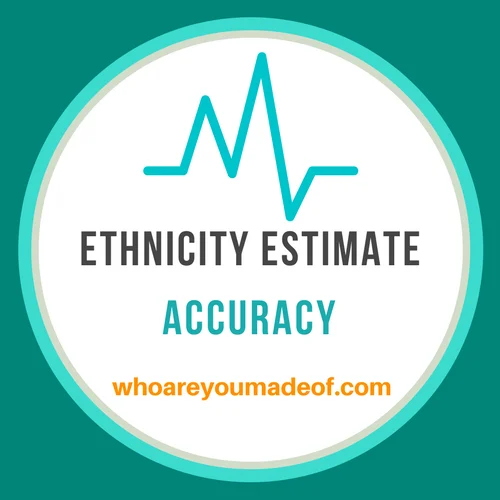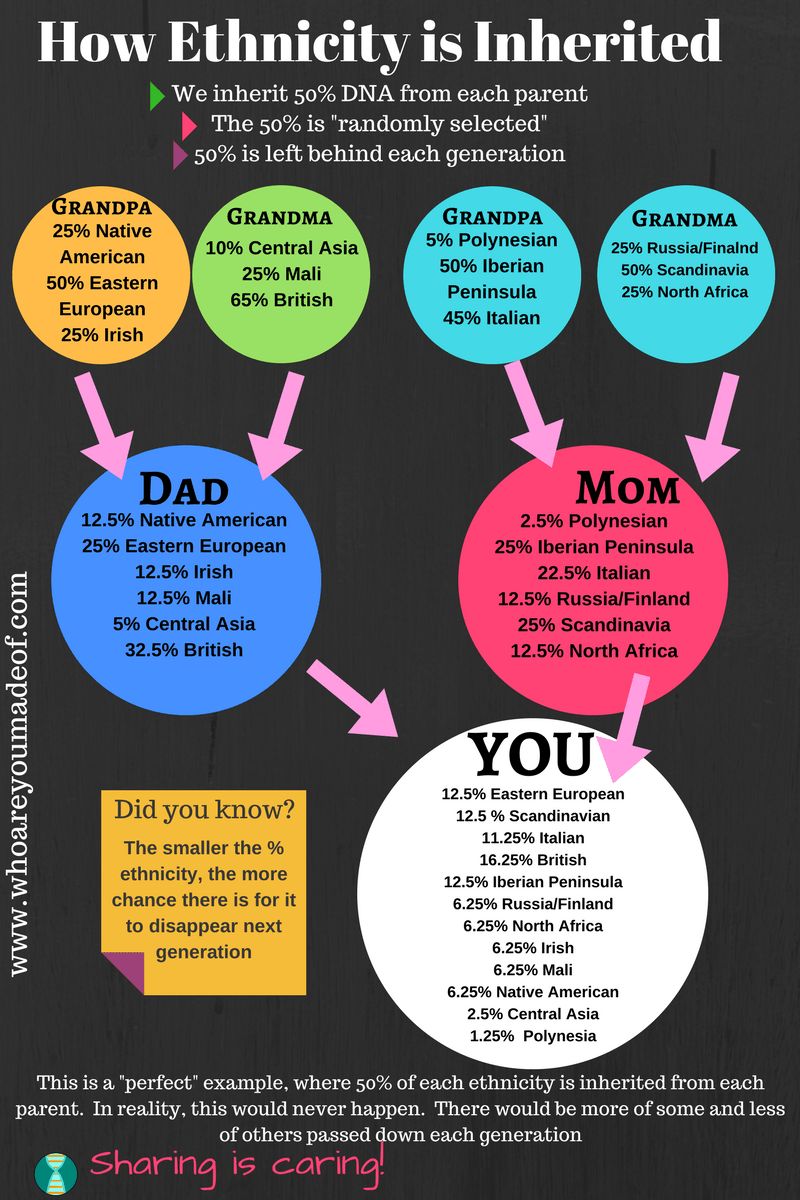Do you want to know if the ethnicity estimate that you received from your DNA test results is accurate? Did you see an ethnicity reported that surprised you?
Most companies say that the ethnicity estimate that they provide you with can go back as far as 500 years, or even a little more. It seems natural to wonder if it possible for them to report a complete ethnicity report covering such a long time period.

In this post, you will learn:
- how they determine your ethnicity
- how far back ethnicity tests can really reach
- which ethnicity estimates you can trust
Hint: Most companies use the word “estimate” for a reason, and if they don’t use the word “estimate, they should.
In the spirit of full disclosure, I am a huge fan of DNA testing and I wish everyone would consider doing it. It can be extremely useful for understanding where your family came from, finding new family members, finding biological family, and researching your family tree.
I feel that it is important for people to know what they are really getting when they get their ethnicity estimate, however.
Understanding ethnicity estimate accuracy
In order to really know whether your report is accurate, you should know a little bit about how they determine your ethnicity, and how far back into history the DNA test can “reach” using current technologies.
How they determine your ethnicity using DNA
Each company uses a slightly different method but the basic process is the following:
- They collect DNA samples from people whose families have lived in specific geographic regions for generations
- Using the collected DNA samples, they create a “reference panel” (the terminology used might vary from company to company)
- When you submit your test, they compare your DNA to the reference panel
- They give you your ethnicity estimate and DNA matches (unless your company doesn’t offer matches as a feature)
As you might be able to guess based on the process that they use to know your ethnicity, the output is only as good as the input. The most important aspect of the process is that they have a large collection of DNA samples that accurately represent the people who live in that region.
There are two ways that this can go wrong:
- The sample database isn’t large enough
- Difficulty finding and verifying DNA from people whose families have always lived in the same area
The biggest challenge is getting a database full of DNA samples that is large enough to be useful.
Additionally, in order to add people to the sample database, you would need to be absolutely 100% sure that the person’s family tree is accurate. In some parts of the world, especially where records are more scarce than others, I wonder how easy this is to do.
How far back ethnicity estimates can reach
Assuming that the company has a really great database, does this mean that they will be able to tell you all of the ethnicities that your family had reaching back 500 years or so?
The answer to this: no. Sure, your ethnicity estimate will be able to tell you some of your ethnicities reaching back 500 years.
Most of the ethnicity that is reported will be more recent, however. In order to understand why, you have to know a little bit about how DNA is inherited.
The type of DNA tests that we are talking about are called autosomal DNA tests.
These tests only test our autosomal chromosomes, as opposed to our sex chromosomes, which contain different information. Autosomal DNA is inherited randomly from each parent (50% from each one).
Every generation, there is some DNA that doesn’t get inherited:
(feel free to download and share this image!)
The example in the image above is in a perfect scenario, where in each generation, exactly 50% of each ethnicity is inherited. There is always some left behind.
If you imagine that determining which DNA a child gets is like reaching into a basket of bits of DNA with your eyes closed, there is no way to know which DNA you’ll grab.
A more realistic scenario would mean that if there was only a small amount of a particular DNA to choose from, like 5-10% Central Asia, for example, it is perfectly reasonable to expect that none of that ethnicity was inherited by the child.
In the basket example, imagine that there are 100 pieces of DNA. What are the odds that you would grab any of that 5-10% DNA from Central Asia?
The smaller the percentage of ethnicity, the bigger the chance that it gets left behind and not passed down to you.
Conversely, it can happen that you randomly inherit all or most (more than the average of 50%) of the DNA of a particular ethnicity from your parent. In the basket example, once again, it can happen that you are “lucky” and grab all of the DNA bits that match Central Asia.
Additionally, there is one important point that I would like to make: If you had a great-great grandparent that was 100% of a particular ethnicity, it is statistically possible to have inherited zero of their ethnicity.
This is because it is possible to share absolutely no DNA with a great-great grandparent. The further back you go, the more likely it is that you share no DNA with them, therefore inherited none of their ethnicity.
Thus, there are two consequences of reading too much into our ethnicity estimates:
- We might completely miss an ethnicity that belonged to one of our ancestors, leading us to believe that our family tree or what we have been told about our family history is wrong
- If we inherit a larger percentage of ethnicity than is usual (more than 50%, for example) it can lead us to believe that the ancestor from that region is closer in generations than they really are. Sometimes this can also lead us to believe that we have a secret or mystery in the family.
Which companies provide the most accurate ethnicity estimate?
The top three DNA testing companies, Ancestry DNA, Family Tree DNA, and 23 and Me, provide estimates that are as accurate as they can be, considering that it is impossible to provide a 100% accurate ethnicity report.
Why is it impossible?
- Because of the way DNA is inherited, you can have more, less, or none of the ethnicity that you expect to find
- Even if someone’s family has historically lived in Britain, for example, they may have ethnicities from other places. So if you know that your great-grandfather was a British immigrant, it doesn’t mean that he had 100% British DNA.
- For a region like North and South America, people who have indigenous ancestry will typically only show “Native American”, since the technology is not yet good enough to isolate specific regions.
If you are considering doing a DNA test with a company that I did not list above, you should know that you will have to take your ethnicity report with a grain of salt and do your own research to see if it lines up with your family tree.
Is there a way to get an alternative ethnicity estimate?
If you are unhappy with your ethnicity estimate, you are in luck. You can just get a different one! In fact, there are several ways to get a different estimate which might (or might not) show you what you are looking for.
There are various legitimate websites which allow you to upload your raw DNA file and get ethnicity estimates, as well as additional DNA matches. This can sometimes be helpful because each company or researcher uses a different reference population to compare with your DNA.
While your estimate should be largely similar to your original company’s estimate (unless you test with a less reliable or experienced company), you might be able to find something helpful in your alternate DNA estimate. Here is a list of places you can use to upload your DNA, some free, some not:
- Gedmatch (free)
- Family Tree DNA (free upload and matches, $19 for unlocked ethnicity estimate and chromosome browser)
- My Heritage DNA (free)
If you want to know even more about your family’s ethnicites, you should consider having your parents (or siblings, if your parents can’t or won’t test), aunts, uncles, or even grandparents do a test.
They will each have slightly different ethnicity results that can help you get a more complete picture of your family history.
Conclusion
With all of the information I provided, you might be wondering why anyone even does these DNA tests anyway?
Like I mentioned before, an ethnicity estimate isn’t going to tell you everything about the ethnicities of all of your ancestors going back 500 years, but it is going to tell you a lot about many of them. This can be an extremely helpful snapshot of your family’s ancestry.
Have you found anything unusual in your ethnicity estimate? What was your experience? I would love to hear from you in the comments!



Mercedes
Saturday 27th of January 2018
Thank you so much for pointing this out to me... I am going to work on the corrections straight away.
Thomas Williams
Thursday 25th of January 2018
On the chart the "YOU" circle has several mistakes and two omissions. Eastern European is 12.5%. Central Asia is 2.5%. Iberian Peninsula is 12.5%. Missing: Italian is 11.25% and Scandinavia is 12.5%.
Mercedes
Sunday 28th of January 2018
Hi Thomas, Thanks for your comment and for pointing out the mistakes. It's hard for me to spot them sometimes, so I am glad for the help :) I'm working on fixing the chart. Have a great day!